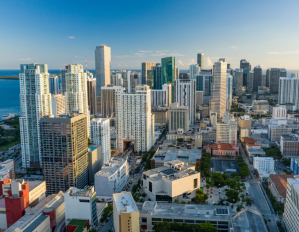Flex Office Space Shows Continued Gains
Some providers are seeing occupancy rates approaching pre-pandemic levels, according to the latest CommercialEdge report.
The office landscape has evolved post-pandemic, leading to the growth of flexible spaces like coworking, the latest CommercialEdge office report shows. Demand for flexible offices has increased, with providers seeing improved occupancy rates approaching pre-pandemic levels. WeWork, for example, reported rising occupancy in the first quarter of 2023. The global coworking industry is projected to grow at an annual rate of 17 percent, exceeding $30 billion by 2026.
In the U.S., there are around 5,600 active shared office space locations, comprising over 115 million square feet of space. Although coworking’s market penetration is relatively small compared to other office niches, it is expected to continue growing. Key markets such as Manhattan, Brooklyn, Washington, D.C., Los Angeles, and Chicago have a significant share of flexible office space. In addition to major players, there are over 2,000 traditional coworking operators nationwide. This being said, building owners are recognizing the potential and offering their own flexible office solutions for vacant inventory.
READ ALSO: A Closer Look at Tech Layoffs’ Impact on Office Leasing
Nationwide, the under-construction pipeline had 118.2 million square feet of new office space under construction, or 1.8 percent of total stock. More than 300 million square feet was in the planning stages, pushing the total supply pipeline to 5.6 percent. Some 3.6 percent of all the office supply currently being constructed consists of Class A and A+ properties, totaling 109.9 million square feet.
The office-using sector showed signs of recovery in April, adding 67,000 new jobs year-over-year, a 2.0 percent increase. The growth was primarily driven by increased hiring in the financial activities sector, which added 23,000 jobs, with significant gains in insurance carriers and related activities (+15,000) and real estate (+9,000). The professional and business services sector also contributed to the overall increase in office-using employment, adding 43,000 jobs in April.
Tech-centric markets face ongoing struggle
The national office vacancy rate continued its upward trajectory, clocking in at 16.7 percent at the end of April, a 10-basis point increase from the month prior and up 100 basis points from the same period last year. Markets with a strong tech footprint recorded the highest vacancy rates, with Austin (22.0 percent), Denver (19.9 percent), San Francisco (19.4 percent) and Seattle (19.0 percent) leading the way.
Meanwhile, national average full-service equivalent listing rates averaged $38.23 per square foot in April, down 230 basis points year-over-year. Average in-place rents increased most dramatically in San Diego (17.9 percent year-over-year), Philadelphia (8.9 percent), Boston (8.8 percent), Seattle (8.1 percent) and Orlando, Fla., (7.8 percent).
Read the full CommercialEdge office report.








You must be logged in to post a comment.